Cultivating the Garden of Health: Holistic Practices for a Fit Body
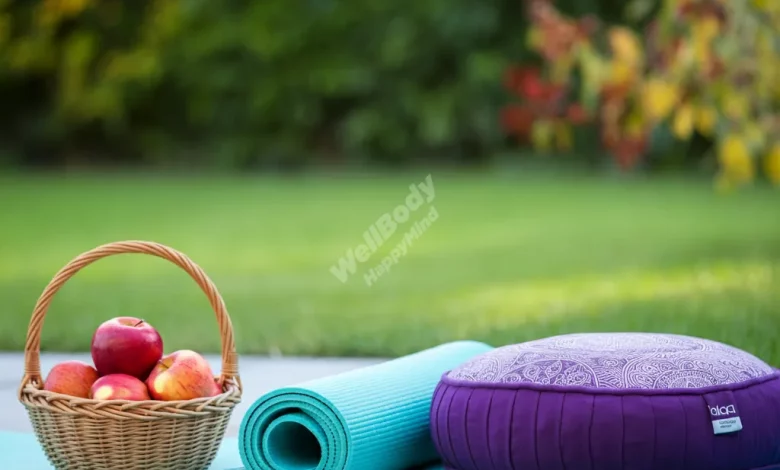
I. Introduction
Did you know that your body is like a garden, constantly growing and changing? Just as a garden needs sunlight, water, and care to thrive, your body requires a holistic approach to achieve true health and fitness. Welcome to the world of holistic health practices, where we nurture our bodies, minds, and spirits to create a vibrant, flourishing “garden of health.”
In this blog post, we’ll explore natural fitness methods and mind-body wellness techniques that can help you cultivate a fit body and a happy mind. From nourishing nutrition to energizing exercises, we’ll uncover the secrets to growing your own garden of well-being. Are you ready to dig in and discover how to bloom into your healthiest self?
II. Understanding Holistic Health
Holistic health is an approach to wellness that considers the whole person – body, mind, and spirit. It’s based on the idea that these aspects of our being are interconnected and influence each other. Instead of just treating symptoms, holistic health aims to address the root causes of health issues and promote overall well-being.
The key principles of holistic health include:
- Interconnectedness: Your physical health affects your mental state, and vice versa.
- Balance: Achieving harmony in all areas of life is crucial for optimal health.
- Individuality: Each person’s path to wellness is unique.
- Prevention: Focusing on maintaining good health rather than just treating illness.
Imagine your body as a complex ecosystem. Just as the health of a forest depends on the well-being of its trees, soil, and wildlife, your overall health relies on the balance of various aspects of your life. This is why holistic health practices consider factors like nutrition, exercise, stress management, and emotional well-being.
By adopting a holistic approach to fitness, you can enjoy benefits such as:
- Improved physical health
- Enhanced mental clarity
- Better stress management
- Increased energy levels
- Greater sense of purpose and fulfillment
Remember, holistic health isn’t about quick fixes. It’s about creating sustainable lifestyle changes that nourish your body, mind, and spirit for long-term wellness.
III. Nourishing the Body: Holistic Nutrition

Holistic nutrition is a cornerstone of natural fitness methods. It focuses on nourishing your body with whole foods that provide essential nutrients, support bodily functions, and promote overall well-being.
Whole foods are foods that are minimally processed and free from artificial additives. They include:
- Fruits and vegetables
- Whole grains
- Lean proteins
- Nuts and seeds
- Legumes
These foods are packed with vitamins, minerals, fiber, and antioxidants that help your body thrive.
Plant-based eating is gaining popularity in holistic health circles due to its numerous benefits:
- Lower risk of heart disease
- Better weight management
- Improved digestion
- Reduced environmental impact
However, remember that a balanced diet can include moderate amounts of lean meats, fish, and dairy if that suits your individual needs.
Mindful eating is another crucial aspect of holistic nutrition. It involves:
- Paying attention to hunger and fullness cues
- Eating slowly and savoring each bite
- Appreciating the colors, smells, and textures of your food
- Avoiding distractions like TV or phones while eating
Here’s a list of some nutrient-dense foods to include in your diet:
- Leafy greens: Spinach, kale, Swiss chard
- Berries: Blueberries, strawberries, raspberries
- Nuts: Almonds, walnuts, cashews
- Fatty fish: Salmon, mackerel, sardines
- Whole grains: Quinoa, brown rice, oats
- Legumes: Lentils, chickpeas, black beans
- Fermented foods: Yogurt, kefir, sauerkraut
Remember, holistic nutrition is about nourishing your body, not restricting it. Listen to your body’s needs and choose foods that make you feel energized and vibrant.
IV. Moving with Purpose: Holistic Exercise
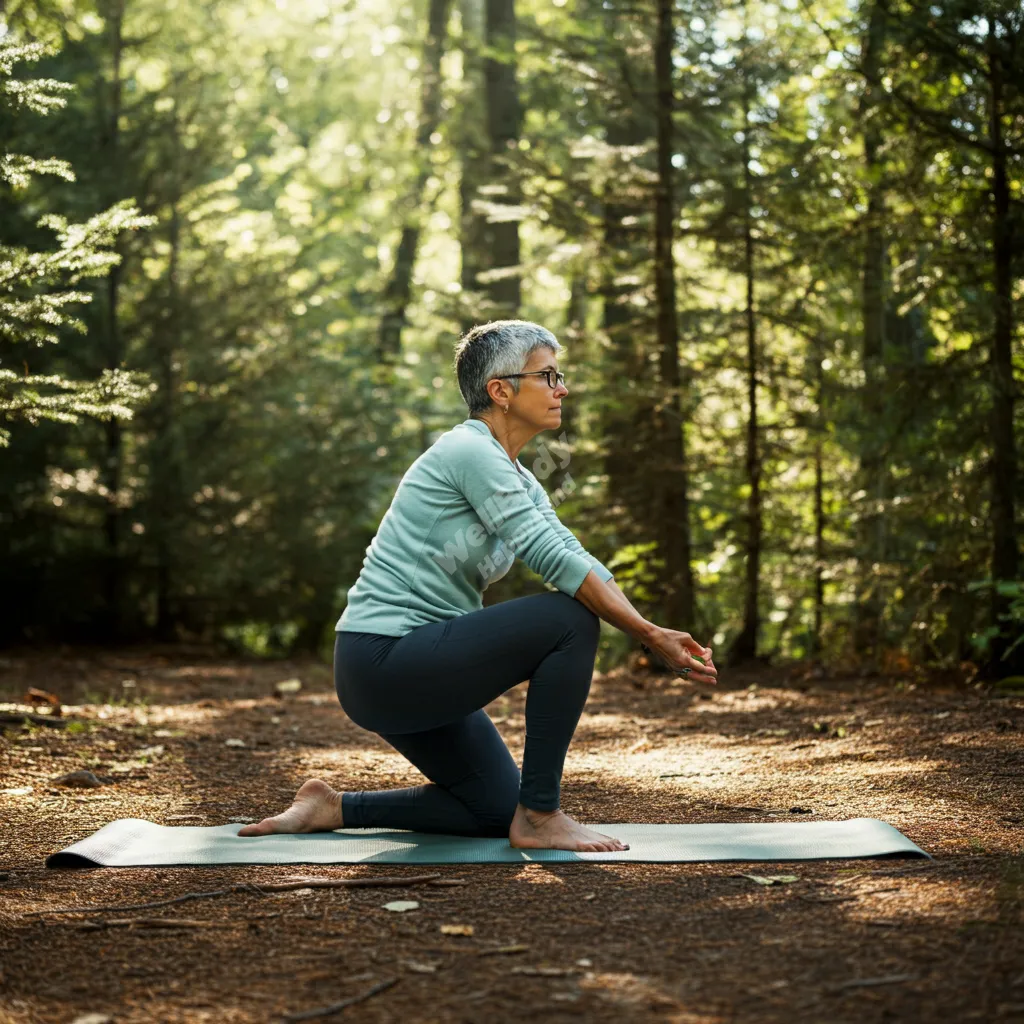
Holistic exercise goes beyond just burning calories or building muscle. It’s about moving your body in ways that promote overall wellness, including physical strength, mental clarity, and emotional balance.
The importance of varied physical activities cannot be overstated. Different types of exercise benefit your body in unique ways:
- Cardiovascular exercises improve heart health and endurance
- Strength training builds muscle and supports bone density
- Flexibility exercises enhance range of motion and prevent injuries
- Balance exercises improve coordination and stability
Mind-body exercises are a crucial component of holistic fitness. These practices integrate physical movement with mental focus and often incorporate breathing techniques. Popular mind-body exercises include:
- Yoga: Combines physical postures, breathing exercises, and meditation
- Tai Chi: A gentle Chinese martial art focusing on flowing movements
- Qigong: Involves coordinated body posture, movement, and breathing
Functional fitness is another key aspect of holistic exercise. This approach focuses on training your body for daily activities, improving your quality of life. Benefits include:
- Better posture and balance
- Increased strength for everyday tasks
- Reduced risk of injury
- Enhanced overall body awareness
Here’s a comparison table of different types of exercises:
| Exercise Type | Physical Benefits | Mental/Emotional Benefits |
|---|---|---|
| Yoga | Flexibility, strength, balance | Stress reduction, mindfulness |
| Running | Cardiovascular health, endurance | Mood boost, mental clarity |
| Weight lifting | Muscle strength, bone density | Confidence, goal setting |
| Swimming | Full-body workout, low impact | Relaxation, stress relief |
| Dance | Coordination, agility | Self-expression, joy |
Remember, the best exercise routine is one that you enjoy and can stick to consistently. Mix and match different activities to keep your workouts interesting and beneficial for both body and mind.
V. Cultivating Mental Wellness

Mental wellness is a crucial component of holistic health. It involves nurturing your mind and emotions to achieve a state of balance and resilience. Here are some key aspects of cultivating mental wellness:
Stress Management Techniques
Chronic stress can have detrimental effects on both physical and mental health. Implementing effective stress management techniques is essential for overall well-being. Here’s a bullet point list of stress-reduction techniques:
- Deep breathing exercises: Slow, deliberate breathing to activate the body’s relaxation response
- Progressive muscle relaxation: Tensing and relaxing different muscle groups to release physical tension
- Journaling: Writing down thoughts and feelings to process emotions and gain clarity
- Time management: Prioritizing tasks and setting realistic goals to reduce overwhelm
- Nature therapy: Spending time outdoors to reduce stress and improve mood
- Creative activities: Engaging in art, music, or other creative pursuits as a form of self-expression
Meditation and Mindfulness Practices
Meditation and mindfulness are powerful tools for improving mental health. They can help:
- Reduce anxiety and depression
- Improve focus and concentration
- Enhance self-awareness
- Promote emotional regulation
Mindfulness involves paying attention to the present moment without judgment. You can practice mindfulness through:
- Mindful eating
- Body scan meditations
- Mindful walking
- Observing your thoughts without getting caught up in them
Importance of Quality Sleep
Sleep plays a vital role in mental wellness. Poor sleep can lead to increased stress, mood disturbances, and cognitive difficulties. To improve sleep quality:
- Stick to a consistent sleep schedule
- Create a relaxing bedtime routine
- Limit screen time before bed
- Ensure your sleeping environment is dark, quiet, and cool
- Avoid caffeine and heavy meals close to bedtime
Remember, cultivating mental wellness is an ongoing process. Be patient with yourself and celebrate small improvements along the way.
VI. Natural Healing Modalities
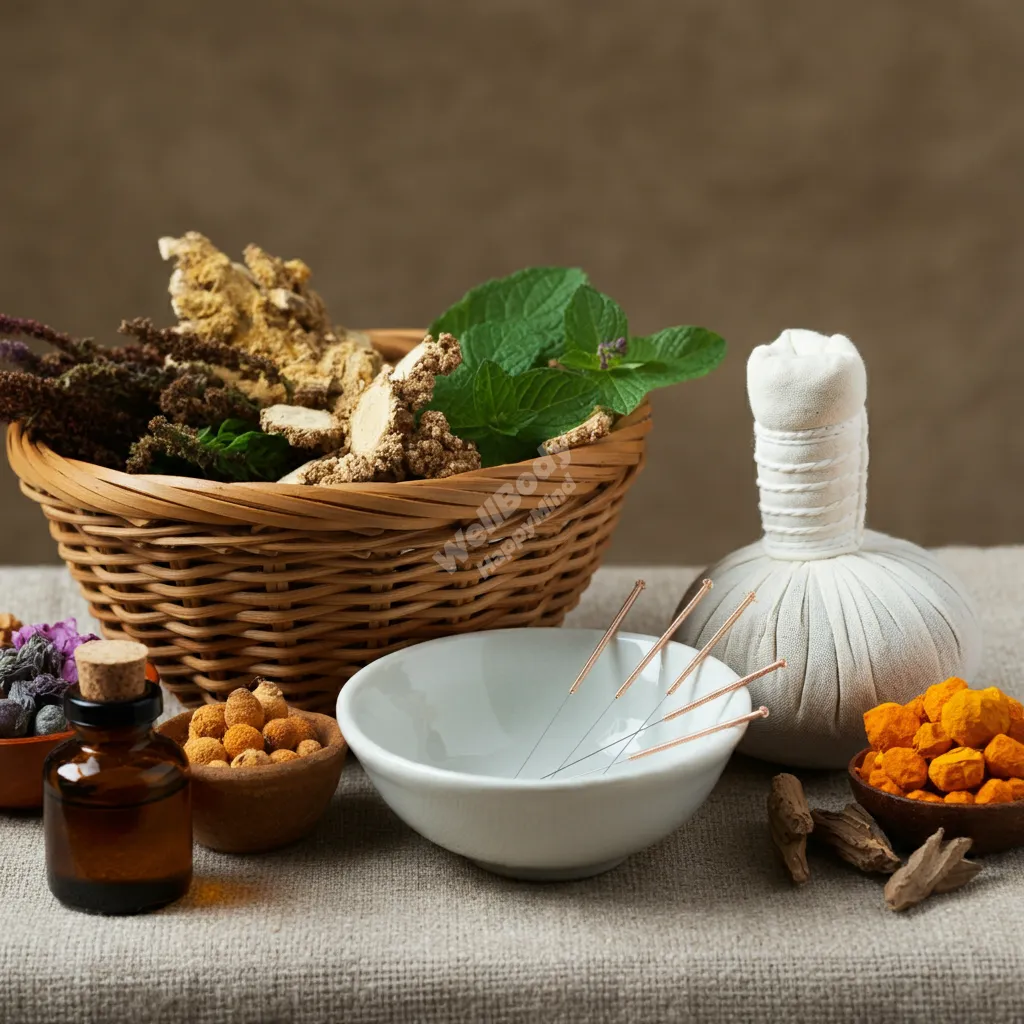
Natural healing modalities are an integral part of holistic health practices. These approaches aim to support the body’s innate healing abilities and promote overall wellness. Let’s explore three popular natural healing modalities:
Herbal Medicine and Its Applications
Herbal medicine uses plants and plant extracts to prevent and treat various health conditions. Some key points about herbal medicine include:
- It’s one of the oldest forms of medicine, used for thousands of years
- Herbs can be consumed as teas, tinctures, capsules, or applied topically
- Many modern pharmaceuticals are derived from herbs
Common herbs and their potential benefits:
- Echinacea: May boost immune system
- Ginger: Can help with nausea and inflammation
- Chamomile: Often used for relaxation and sleep support
- Turmeric: Known for its anti-inflammatory properties
Acupuncture and Traditional Chinese Medicine (TCM)
Acupuncture is a key component of TCM, involving the insertion of thin needles into specific points on the body.
- Based on the concept of balancing the flow of energy (Qi) in the body
- May help with pain management, stress reduction, and various health conditions
- Often used in combination with other TCM practices like herbal medicine and cupping
Ayurveda: The Science of Life
Ayurveda is an ancient Indian healing system that emphasizes balance between body, mind, and spirit.
Key principles of Ayurveda:
- Identifies three main body types or doshas: Vata, Pitta, and Kapha
- Recommends personalized diet and lifestyle practices based on your dosha
- Utilizes herbs, massage, yoga, and meditation for healing
- Focuses on prevention and maintaining overall health
Brief Overview of Each Modality:
| Modality | Origin | Key Concepts | Common Practices |
|---|---|---|---|
| Herbal Medicine | Various cultures worldwide | Plants have healing properties | Herbal teas, tinctures, supplements |
| Acupuncture/TCM | Ancient China | Balance of Qi (energy) | Needle insertion, herbal remedies |
| Ayurveda | Ancient India | Balance of doshas (body types) | Diet, herbs, yoga, meditation |
Remember, while these natural healing modalities can be beneficial, it’s important to consult with qualified practitioners and inform your healthcare provider, especially if you have existing health conditions or are taking medications.
VII. Detoxification and Cleansing
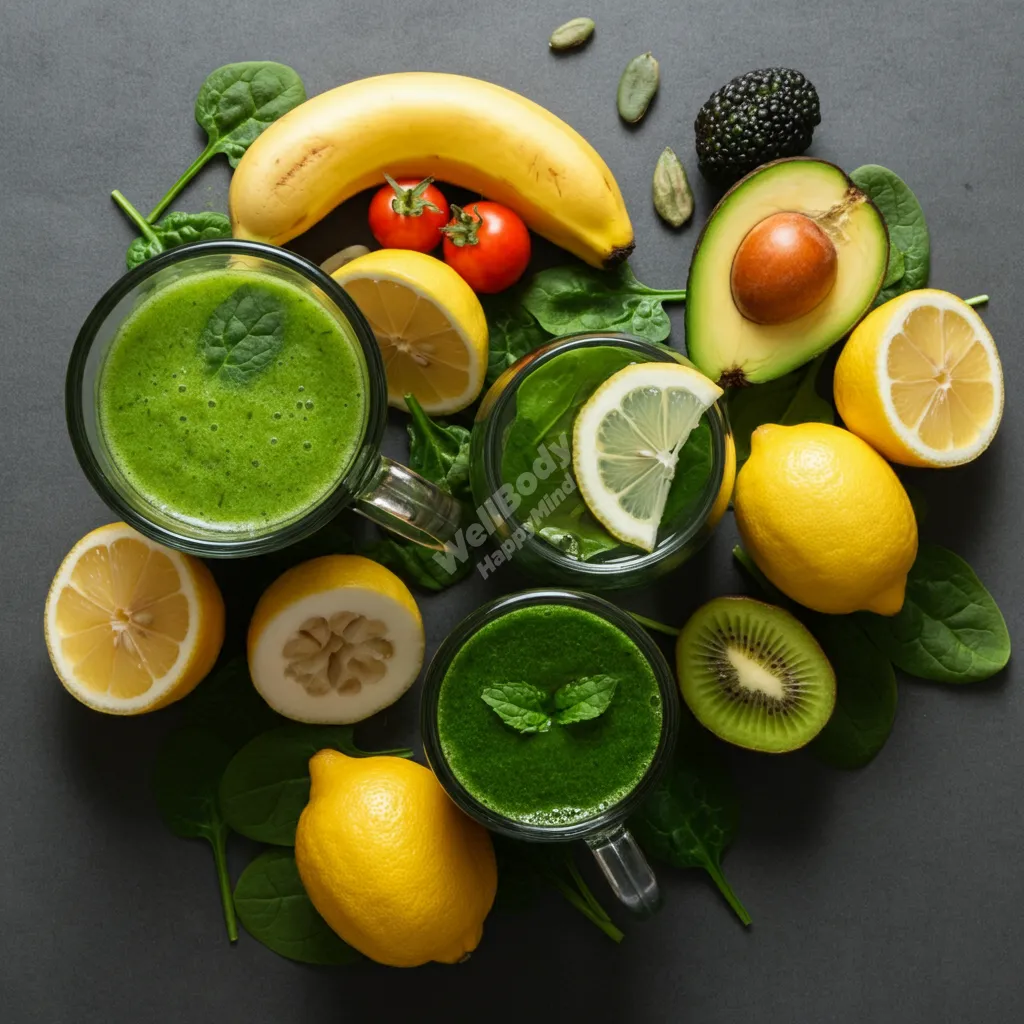
Detoxification is a natural process that our bodies perform constantly to eliminate toxins and waste. While our bodies are equipped with efficient detox systems, we can support these processes through certain practices. Let’s explore detoxification from a holistic health perspective:
Understanding the Body’s Natural Detox Processes
Our bodies have several organs that work together to detoxify:
- Liver: The primary detox organ, filtering blood and processing toxins
- Kidneys: Filter waste from blood and excrete it through urine
- Lungs: Expel gaseous waste products
- Skin: Eliminates toxins through sweat
- Colon: Removes solid waste and toxins
Safe and Effective Detox Practices
While extreme “detox diets” can be harmful, there are gentle ways to support your body’s natural detoxification:
- Eat a clean diet: Focus on whole, unprocessed foods
- Stay hydrated: Drink plenty of water to help flush out toxins
- Exercise regularly: Promotes circulation and sweating
- Get adequate sleep: Allows your body time to repair and detoxify
- Practice stress-reduction techniques: Chronic stress can hinder detoxification
The Role of Hydration in Cleansing
Water is crucial for detoxification. It helps:
- Flush out toxins through urine and sweat
- Support kidney function
- Promote regular bowel movements
- Maintain cellular health
Detoxifying Foods and Drinks
Here’s a list of foods and drinks that can support your body’s natural detox processes:
- Leafy greens (spinach, kale): Rich in chlorophyll, which aids in detoxification
- Citrus fruits: High in vitamin C, which supports the production of glutathione, a powerful antioxidant
- Garlic: Contains sulfur compounds that support liver function
- Green tea: Contains catechins, antioxidants that support liver function
- Beets: Support liver health and help purify blood
- Turmeric: Has anti-inflammatory properties and supports liver function
- Lemon water: Can aid digestion and support hydration
- Dandelion tea: May support liver function and act as a natural diuretic
Remember, the best “detox” is a healthy lifestyle that supports your body’s natural processes. Avoid extreme detox diets or cleanses, as these can be harmful and are often unnecessary.
VIII. Balancing Energy: The Chakra System
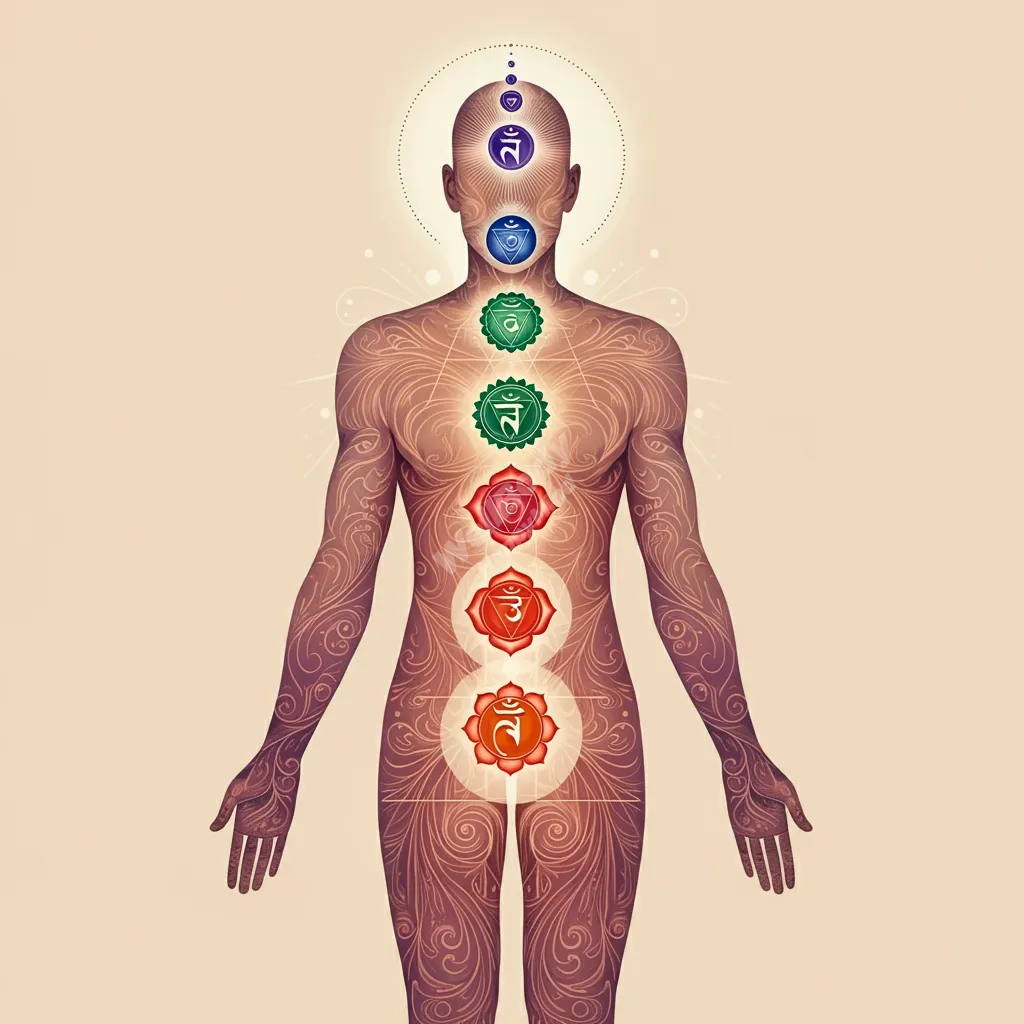
The chakra system is an ancient concept from Indian philosophy that plays a significant role in many holistic health practices. It’s based on the idea that there are seven main energy centers in the body, each associated with different aspects of physical, emotional, and spiritual well-being.
Introduction to the Seven Chakras
Here’s a simple overview of the seven main chakras:
- Root Chakra (Muladhara): Located at the base of the spine, associated with stability and security
- Sacral Chakra (Svadhisthana): Located in the lower abdomen, linked to creativity and emotions
- Solar Plexus Chakra (Manipura): Located in the upper abdomen, related to self-confidence and personal power
- Heart Chakra (Anahata): Located in the center of the chest, associated with love and compassion
- Throat Chakra (Vishuddha): Located in the throat, linked to communication and self-expression
- Third Eye Chakra (Ajna): Located between the eyebrows, associated with intuition and wisdom
- Crown Chakra (Sahasrara): Located at the top of the head, related to spiritual connection and enlightenment
Practices for Chakra Alignment
Various mind-body wellness techniques can help balance and align the chakras:
- Meditation: Focusing on each chakra during meditation can help balance energy
- Yoga: Certain yoga poses are believed to activate specific chakras
- Color therapy: Each chakra is associated with a color; surrounding yourself with these colors can stimulate the chakras
- Sound therapy: Chanting or listening to specific frequencies can help balance chakras
- Crystal healing: Different crystals are thought to resonate with different chakras
How Balanced Chakras Contribute to Overall Health
Proponents of chakra healing believe that when these energy centers are balanced:
- Physical health improves
- Emotional well-being is enhanced
- Mental clarity increases
- Spiritual growth is facilitated
While scientific evidence for chakra healing is limited, many people find these practices beneficial as part of a holistic approach to wellness.
Remember, chakra balancing is just one aspect of holistic health. It’s most effective when combined with other natural fitness methods and a healthy lifestyle.
IX. Creating a Holistic Lifestyle

Embracing a holistic lifestyle means integrating various holistic health practices into your daily routine. This approach can lead to improved overall well-being and a more balanced life. Let’s explore how to create a personalized holistic health plan and incorporate it into your daily life.
Developing a Personalized Holistic Health Plan
- Assess your current state: Evaluate your physical, mental, and emotional health.
- Set realistic goals: Determine what areas you want to improve.
- Choose appropriate practices: Select holistic methods that align with your goals and preferences.
- Start small: Begin with one or two new practices and gradually add more.
- Monitor progress: Regularly check in with yourself to see what’s working and what’s working and what isn’t.
Incorporating Holistic Practices into Daily Routines
Here’s a sample daily holistic health routine:
Morning:
- Start with a 10-minute meditation or yoga session
- Drink warm lemon water to support digestion
- Eat a nutritious breakfast with whole foods
Midday:
- Take a short walk during lunch break
- Practice deep breathing exercises to manage stress
- Choose a balanced, plant-based lunch
Evening:
- Engage in a form of exercise you enjoy (e.g., jogging, swimming, dance)
- Prepare a healthy dinner using whole ingredients
- Practice gratitude journaling before bed
Throughout the day:
- Stay hydrated
- Take short breaks for stretching or mindfulness
- Use natural remedies for minor ailments when appropriate
The Importance of Consistency and Patience
Adopting a holistic lifestyle is a journey, not a destination. Keep in mind:
- Consistency is key: Regular practice leads to lasting changes.
- Be patient: It takes time to see and feel the benefits of holistic practices.
- Listen to your body: Adjust your routine as needed based on how you feel.
- Celebrate small wins: Acknowledge progress, no matter how small.
- Stay flexible: Be willing to modify your approach if something isn’t working.
Remember, the goal of a holistic lifestyle is to nurture your body, mind, and spirit in a way that feels authentic and sustainable for you. There’s no one-size-fits-all approach – your holistic journey is uniquely yours.
X. Conclusion
As we wrap up our journey through the garden of holistic health, let’s take a moment to reflect on the key holistic health practices we’ve explored:
- Holistic nutrition: Nourishing our bodies with whole foods and mindful eating
- Holistic exercise: Engaging in varied physical activities and mind-body exercises
- Mental wellness: Cultivating stress management techniques and mindfulness practices
- Natural healing modalities: Exploring herbal medicine, acupuncture, and Ayurveda
- Detoxification: Supporting our body’s natural cleansing processes
- Chakra balancing: Understanding and aligning our energy centers
- Creating a holistic lifestyle: Integrating these practices into our daily routines
Remember, just as a garden doesn’t bloom overnight, cultivating your health is a gradual process. Start small, perhaps by incorporating one new natural fitness method into your routine each week. As you grow more comfortable, you can add more practices, nurturing your garden of health one step at a time.
The beauty of holistic health lies in its comprehensive approach. By tending to your body, mind, and spirit, you’re not just addressing individual symptoms – you’re fostering overall wellness and vitality.
As you embark on your holistic health journey, keep in mind that consistency and patience are your best allies. Some days, your garden may face challenges, but with persistent care and attention, it will flourish.
We encourage you to explore these mind-body wellness techniques, find what resonates with you, and create a holistic lifestyle that supports your unique needs and goals. Remember, you are the gardener of your own health – nurture it with love, attention, and holistic practices, and watch yourself bloom into your healthiest, happiest self.
XI. Additional Resources
To support your journey in holistic health, we’ve compiled a list of recommended books, websites, and organizations. These resources can provide deeper insights into the holistic health practices we’ve discussed and offer additional guidance for your wellness journey.
Recommended Books on Holistic Health:
- “The Body Keeps the Score” by Bessel van der Kolk
- “You Can Heal Your Life” by Louise Hay
- “The Healing Self” by Deepak Chopra and Rudolph E. Tanzi
- “Whole Health” by Mark Mincolla
- “The Complete Book of Ayurvedic Home Remedies” by Vasant Lad
Reputable Websites and Organizations for Further Information:
National Center for Complementary and Integrative Health (NCCIH)
- Offers evidence-based information on various holistic health practices
American Holistic Health Association (AHHA)
- Provides resources and education on holistic health
The Institute for Functional Medicine
- Focuses on a systems biology-based approach to health
- Offers information on yoga, meditation, and holistic living
- Provides articles on various aspects of holistic wellness
- Offers resources on meditation, Ayurveda, and holistic health
Remember, while these resources can be valuable, they should complement, not replace, advice from qualified healthcare professionals. Always consult with a healthcare provider before starting any new health regimen, especially if you have existing health conditions.
As you explore these resources, keep an open mind and listen to your body. The path to holistic wellness is a personal journey, and what works best for you may be a unique combination of different natural fitness methods and mind-body wellness techniques.



